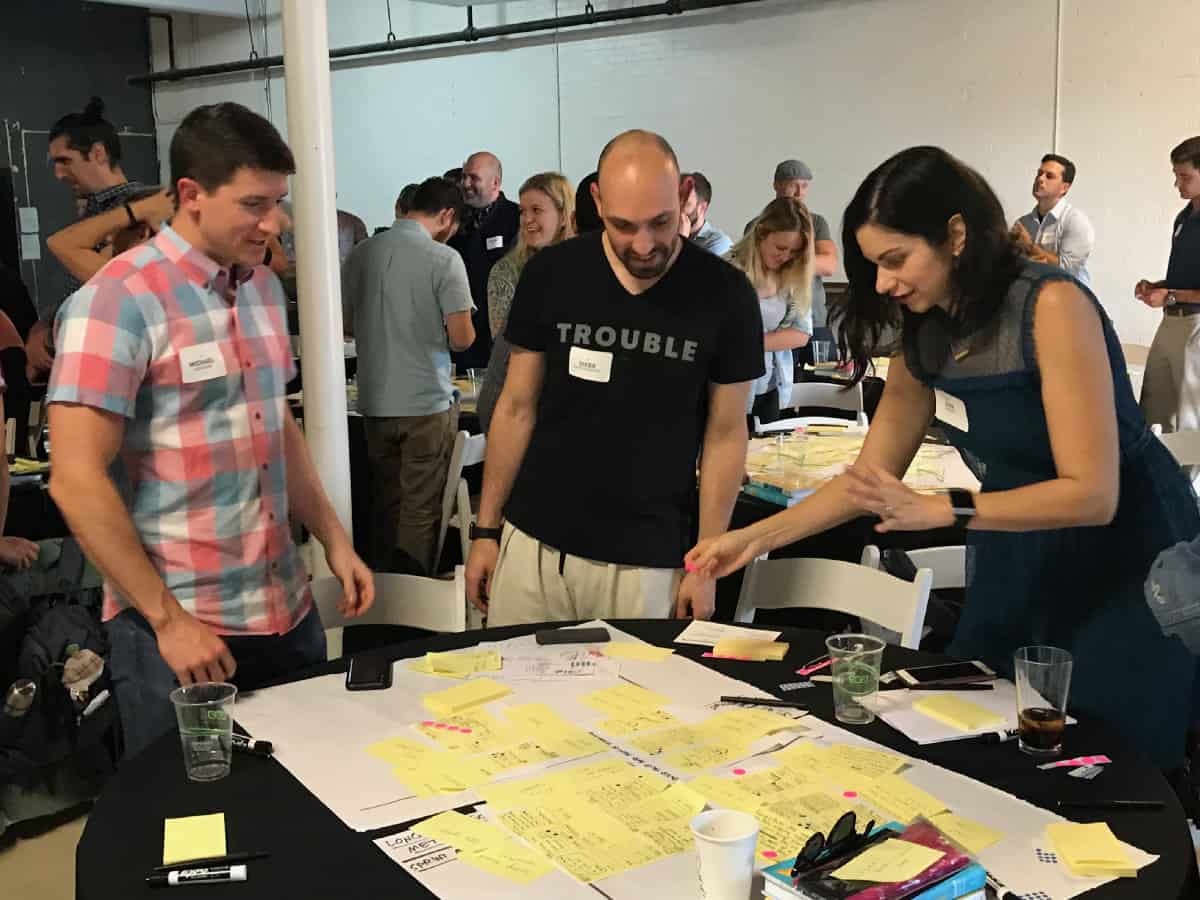Why conventional approaches to innovation don’t work
When creating new ideas, most organizations tackle them in the same old ways. Here’s how it usually goes down:
- A team of experts and leaders gather for a brainstorm session.
- Loaded with political and social dynamics, the team manages to reach consensus and a green light from higher up.
- Off go the designers on a journey to return with a brilliant rendition of what everyone had in their minds.
- Review and revise until you can toss the engineering team a file titled: “great_idea_final_final_final_version17.pdf”
- You know the drill: Scope creep, blown budgets, communication breakdowns, dysfunctional team dynamics.
In the end, you’ve built a mutated version of the original idea, riddled with compromises and bloated with features. And we still have yet to learn if the idea works.

In last week’s, all-day Design Sprint Bootcamp in Austin, TX, Jake Knapp led us through each step of the process he details in his book, Sprint. He compared the conventional ways most groups approach new ideas to the process provided by Design Sprints. The comparisons made the painfully obvious distinction as to why Design Sprints are key to creating innovative products.
“Even if you’re wrong the first time, the sprint process will help you light up your future path.” — Jake Knapp, author of Sprint
Here are a few juxtapositions that I took away from Jake’s event:
Conventional: Group Brainstorm
Typically, members of a team gather in a room, with sleeves rolled up, pens and pads in hand, with wide eyes, full of energy and the best of intentions. Ideas are born and prematurely tossed out of their nests with the hopes 🤞they’ll fly. Usually, the ones that do survive are because the loudest or highest ranking person favored them.
Design Sprint: Work Together, Alone
In Design Sprints, we work together, alone. Each person in a Design Sprint works toward the same task in silence, jotting down thoughts and sketching thumbnails of their vision. This method allows each person to capture enough detail in their solutions. They show the idea instead of only talking about it, leaving little room for misinterpretations when presented.

Conventional: Endless Discussions
The social dynamics of group discussions can kill the momentum of a team’s progress and drain them of their creative energy. And often the best ideas don’t have a chance of making the final cut.
Design Sprint: Fast & Decisive
Through structured conversations you reach decisions quickly — scrap it or keep it. In Design Sprints there is one decider on the team. Activities like silent voting are conducted where the decider sees which idea the group is leaning towards. The decider considers this insight to make a final call on which idea to proceed with.

Conventional: Build an MVP
If you ask 10 members of a product team to define an MVP, you’ll get 10 different answers. MVPs often start small and lean, with enough punch to enter the market. They rarely turn out that way. Many grow so much in complexity that by the time it’s launched into the market, it’s an expensive, unproven idea, loaded with features that could have been added in phases 2, 3 or 4.
Design Sprint: Fake it ’til you make it
Build a fake version, a facade of the idea. It won’t matter if the inner-workings are absent: the code, the real data. If it looks, feels, sounds or smells like the real thing, you have enough to test with real users.
With a Design Sprint prototype, users get immersed in the story and forget that it’s fake. Remember old Western films? The saloons and sheriff’s office were wooden boards propped up vertically with painted on windows and doors. Audiences were focused on the story, the shoot out at high noon, not architectural integrity. Prototypes are enough to acquire candid and useful feedback.

Conventional: Wait for perfect data,
Companies will deploy research agencies to explore what the market wants. Over the course of weeks or months, barrels of data roll in and are distilled into neatly designed graphs and pie charts. Often the data is unclear and you’re scratching your head, wondering how to make sense of it.
Design Sprint: Quick ‘n dirty
Get the critical, impactful insight, now — The stuff that will quickly tell you where to adjust your idea and its chances of surviving in the market.
On the the last day of a Design Sprints is Test Day, where you take your prototype and test it with five real customers. It might seem like a small group to test, but check out the Nielsen Norman Group on why you only need to test with five users.
You get 80% of findings in the first five interviews.
The 1 on 1 interviews shed valuable insight into how your idea will fit in the market. You’ll have more info on the “why.” Plus, the whole team learns by observing the interviews being conducted. Using this scorecard, we capture data such as:
- Did the user understand the overall concept?
- Did the user find the shopping cart?
- Did the user watch the video? (You know… the one that cost $1.2M to produce?)
Closing
“Insanity is doing the same thing over and over again and expecting different results.” –Albert Einstein

We already know one approach to executing on ideas. We know its risks and downfalls. Yet, companies that crave innovation continue to do things the same old way. A new way to innovate is here. Design Sprints are a faster and better way to launch ideas and build better products.
Jake’s event last week recharged my excitement for innovation by leading Design Sprints. It rejuvenated my mission to help businesses build better products and services that are not just profitable, but turn customers into raving fans.


